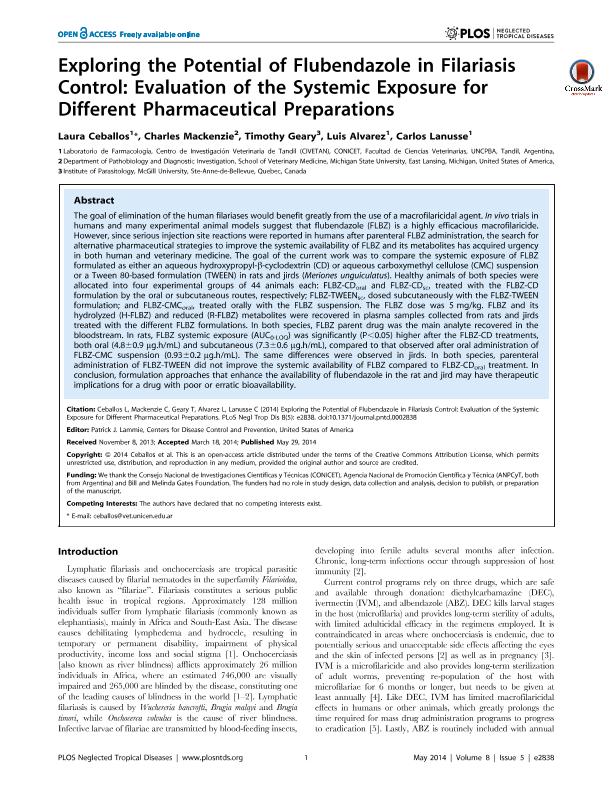Mostrar el registro sencillo del ítem
dc.contributor.author
Ceballos, Laura

dc.contributor.author
Mackenzie, Charles
dc.contributor.author
Geary, Timothy
dc.contributor.author
Alvarez, Luis Ignacio

dc.contributor.author
Lanusse, Carlos Edmundo

dc.date.available
2017-11-10T20:02:04Z
dc.date.issued
2014-05
dc.identifier.citation
Ceballos, Laura; Mackenzie, Charles; Geary, Timothy; Alvarez, Luis Ignacio; Lanusse, Carlos Edmundo; Exploring the potential of flubendazole in filariasis control: evaluation of the systemic exposure for different pharmaceutical preparations; Public Library Of Science; Neglected Tropical Diseases; 8; 5; 5-2014; 2838-2844
dc.identifier.uri
http://hdl.handle.net/11336/27942
dc.description.abstract
The goal of elimination of the human filariases would benefit greatly from the use of a macrofilaricidal agent. In vivo trials in humans and many experimental animal models suggest that flubendazole (FLBZ) is a highly efficacious macrofilaricide. However, since serious injection site reactions were reported in humans after parenteral FLBZ administration, the search for alternative pharmaceutical strategies to improve the systemic availability of FLBZ and its metabolites has acquired urgency in both human and veterinary medicine. The goal of the current work was to compare the systemic exposure of FLBZ formulated as either an aqueous hydroxypropyl-b-cyclodextrin (CD) or aqueous carboxymethyl cellulose (CMC) suspension or a Tween 80-based formulation (TWEEN) in rats and jirds (Meriones unguiculatus). Healthy animals of both species were allocated into four experimental groups of 44 animals each: FLBZ-CDoral and FLBZ-CDsc, treated with the FLBZ-CD formulation by the oral or subcutaneous routes, respectively; FLBZ-TWEENsc, dosed subcutaneously with the FLBZ-TWEEN formulation; and FLBZ-CMCoral, treated orally with the FLBZ suspension. The FLBZ dose was 5 mg/kg. FLBZ and its hydrolyzed (H-FLBZ) and reduced (R-FLBZ) metabolites were recovered in plasma samples collected from rats and jirds treated with the different FLBZ formulations. In both species, FLBZ parent drug was the main analyte recovered in the bloodstream. In rats, FLBZ systemic exposure (AUC0-LOQ) was significantly (P,0.05) higher after the FLBZ-CD treatments, both oral (4.860.9 mg.h/mL) and subcutaneous (7.360.6 mg.h/mL), compared to that observed after oral administration of FLBZ-CMC suspension (0.9360.2 mg.h/mL). The same differences were observed in jirds. In both species, parenteral administration of FLBZ-TWEEN did not improve the systemic availability of FLBZ compared to FLBZ-CDoral treatment. In conclusion, formulation approaches that enhance the availability of flubendazole in the rat and jird may have therapeutic implications for a drug with poor or erratic bioavailability.
dc.format
application/pdf
dc.language.iso
eng
dc.publisher
Public Library Of Science

dc.rights
info:eu-repo/semantics/openAccess
dc.rights.uri
https://creativecommons.org/licenses/by-nc-sa/2.5/ar/
dc.subject
Flubendazole
dc.subject
Filariasis
dc.subject
Cyclodextrins
dc.subject.classification
Otras Ciencias Veterinarias

dc.subject.classification
Ciencias Veterinarias

dc.subject.classification
CIENCIAS AGRÍCOLAS

dc.title
Exploring the potential of flubendazole in filariasis control: evaluation of the systemic exposure for different pharmaceutical preparations
dc.type
info:eu-repo/semantics/article
dc.type
info:ar-repo/semantics/artículo
dc.type
info:eu-repo/semantics/publishedVersion
dc.date.updated
2016-11-17T16:04:02Z
dc.identifier.eissn
1935-2735
dc.journal.volume
8
dc.journal.number
5
dc.journal.pagination
2838-2844
dc.journal.pais
Estados Unidos

dc.journal.ciudad
San Francisco
dc.description.fil
Fil: Ceballos, Laura. Consejo Nacional de Investigaciones Científicas y Técnicas. Centro Científico Tecnológico Conicet - Tandil. Centro de Investigación Veterinaria de Tandil. Universidad Nacional del Centro de la Provincia de Buenos Aires. Centro de Investigación Veterinaria de Tandil. Provincia de Buenos Aires. Gobernación. Comision de Investigaciones Científicas. Centro de Investigación Veterinaria de Tandil; Argentina
dc.description.fil
Fil: Mackenzie, Charles. Michigan State University; Estados Unidos
dc.description.fil
Fil: Geary, Timothy. McGill University; Canadá
dc.description.fil
Fil: Alvarez, Luis Ignacio. Consejo Nacional de Investigaciones Científicas y Técnicas. Centro Científico Tecnológico Conicet - Tandil. Centro de Investigación Veterinaria de Tandil. Universidad Nacional del Centro de la Provincia de Buenos Aires. Centro de Investigación Veterinaria de Tandil. Provincia de Buenos Aires. Gobernación. Comision de Investigaciones Científicas. Centro de Investigación Veterinaria de Tandil; Argentina
dc.description.fil
Fil: Lanusse, Carlos Edmundo. Consejo Nacional de Investigaciones Científicas y Técnicas. Centro Científico Tecnológico Conicet - Tandil. Centro de Investigación Veterinaria de Tandil. Universidad Nacional del Centro de la Provincia de Buenos Aires. Centro de Investigación Veterinaria de Tandil. Provincia de Buenos Aires. Gobernación. Comision de Investigaciones Científicas. Centro de Investigación Veterinaria de Tandil; Argentina
dc.journal.title
Neglected Tropical Diseases

dc.relation.alternativeid
info:eu-repo/semantics/altIdentifier/doi/http://dx.doi.org/10.1371/journal.pntd.0002838
dc.relation.alternativeid
info:eu-repo/semantics/altIdentifier/url/https://www.ncbi.nlm.nih.gov/pmc/articles/PMC4038472/
dc.relation.alternativeid
info:eu-repo/semantics/altIdentifier/url/https://doaj.org/article/895854c466d345af95aa7eb66cb075a2
dc.relation.alternativeid
info:eu-repo/semantics/altIdentifier/url/http://journals.plos.org/plosntds/article?id=10.1371/journal.pntd.0002838
Archivos asociados
